
11 minute read
A SHOT IN THE DARK

A SHOT IN THE DARK WHAT IS BLACKWATER DIVING?
FEATURE AND PHOTOGRAPHY JESPER KJØLLER ILLUSTRATION ALEXANDRA HUTH
Blackwater diving is a relatively new discipline in underwater photography. Traditionally, divers have primarily studied reef or bottom dwelling life forms while maybe occasionally gazing out in the blue for the random chance of spotting passing pelagic wildlife. But during a blackwater dive, you explore the open ocean at night where the majority of the earth’s biomass is concentrated.
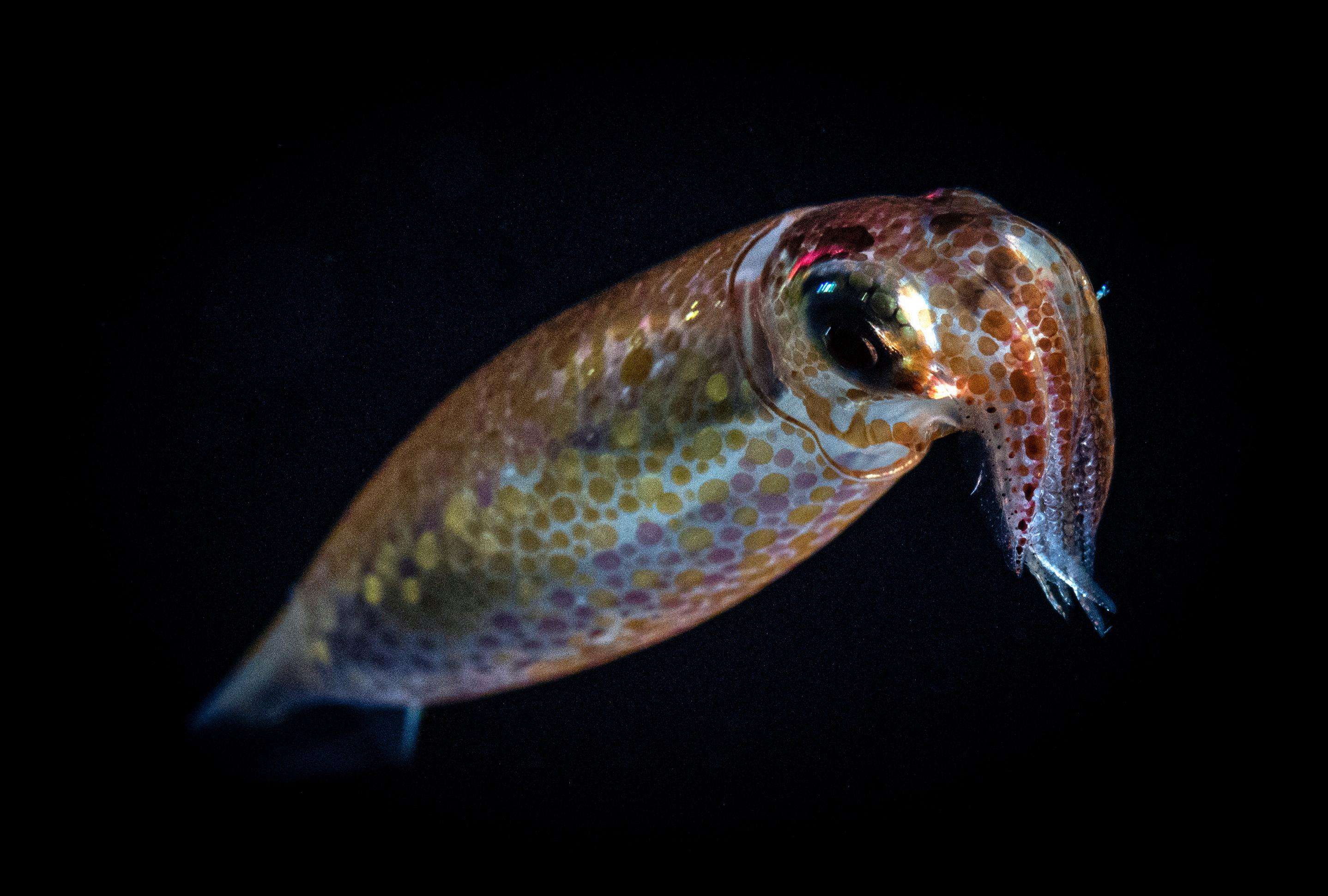
Being on a boat during a dark moonless evening could have been serene, but the silence is disturbed by muffled and distant club music from a party somewhere on shore. Deep disco rhythms seem strangely out of place in the black night, but in the Philippines, they rarely miss a chance to have a good fiesta.
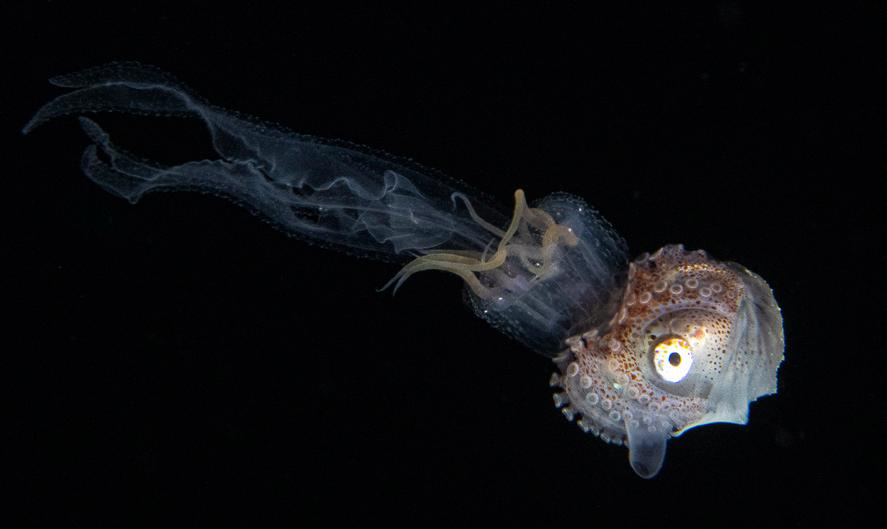
The crew on our bangka prepares the blackwater rig – a weighted line with a buoy and strong lights attached. They work methodically – it’s apparent that they have done this before. We left the resort around sunset just 20 minutes ago, and we arrive in Moalboal Bay as the tropical night falls.
The crew heave the finished rig out in the allegedly 500-metre deep black ocean and we wait. The line needs to “cook” as they say. Leaving the rig in the water for about 30 minutes before we jump in should ensure that the shine attracts the critters.

The light rig actually serves three purposes. Firstly, it entices the organisms in the dark ocean. But since there must be loads of plankton and larvae in the water column already – even if we just dived with our own torches – the second purpose is to serve as a reference point for the dive – both for depth and orientation. The third purpose is to make it easy for the boat to follow the floating divers and the line drifting with the current. Since divers are travelling at the same speed, the current is not felt.
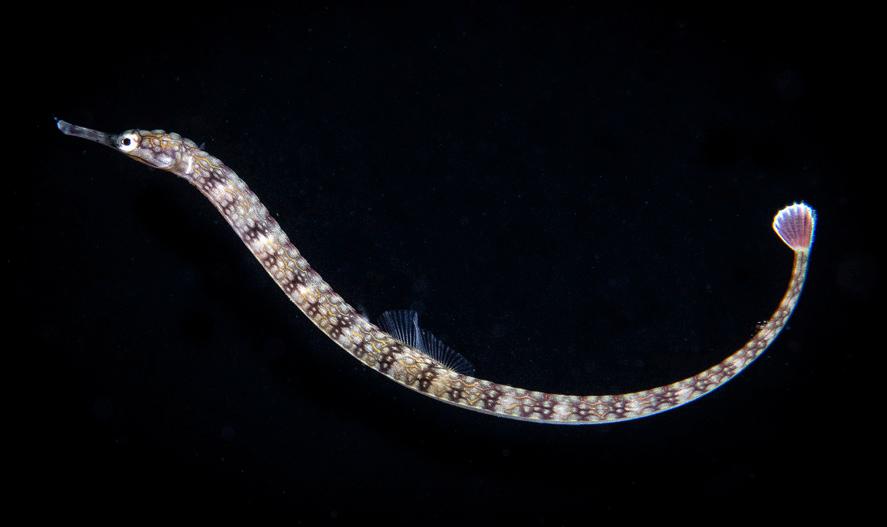
SNOWSTORM
After the cooking, the boat slowly approaches the bright pool of light around the buoy supporting the line. We jump in and a crew member hands me my camera. The water is a nice and pleasant 30 degrees, but I was recommended to wear a hood to protect me from stinging hydroids floating around. I’m almost too warm, so I let a little water flow into my suit to cool me down. After exchanging quick OK’s and thumbs down, we descend close to the line.
This is my first attempt at blackwater photography, so I don’t know what to expect. If a normal night dive gives you the creeps and invokes your inner boogie man, then blackwater diving is probably not your thing. But for me, the dark and warm water has a strangely soothing effect, and I immediately go into the zone.
I let my eyes adapt to the conditions and I look around to assess the results of the “cooking”. I see nothing. Well, I see snow. Lots of snow. The powerful lights on the line creates the same effect as headlights in a snowstorm and I’m worried that I will get nothing but backscatter in my images.

Then I remember my first muck-dive many years ago in Lembeh Strait. I had the same feeling of, “what am I doing here?” and I tell myself to be patient. I look around to orient myself – I swim farther away from the strong glare of the lights on the line and I discover that it is better not to be too close to the light cones on the rig.
After a few minutes, I spot a small jellyfish the size of a coin. All right. Game on! I approach with care and try to take a few pictures. The first few images are completely dark, but after some exposure adjustments and experiments, I begin to get a few acceptable shots, and I feel more confident. I can do this! I lookaround for more subjects, but after another five minutes there is still nothing but snow.
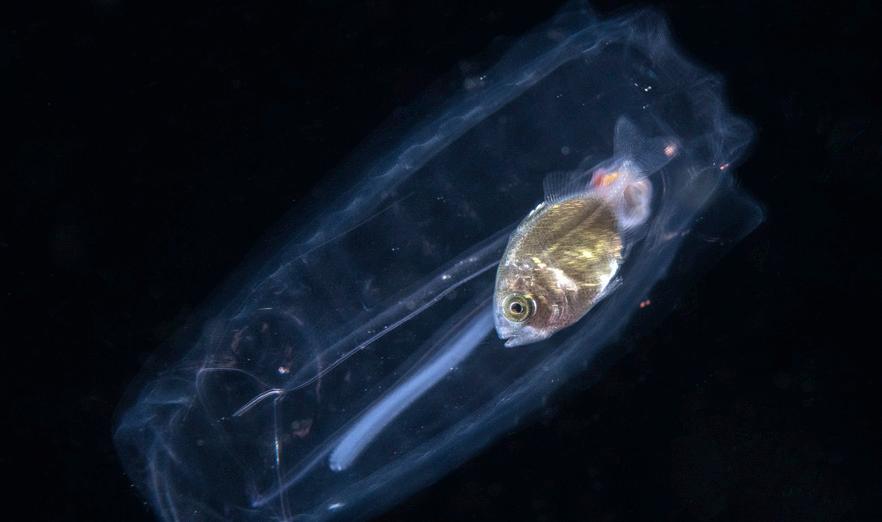
JEDI (K)NIGHT
Suddenly, Felix, my reliable Filipino guide signals with his light. He is using a strong torch with a very narrow beam. It cuts through the dark like a lightsabre. I imagine the swooshing sound and I can almost hear the glaring fanfares from the Star Wars theme. He beckons me with his torch and points in the direction of… eh –what is that? In the magnification of my viewfinder, I suddenly recognise a wellknown character. It is a juvenile Flying Gunnard the size of my little finger. Felix is noticeably excited – after the dive he tells me that this is the first time he sees one. Good star t! The Gunnard is difficult to get in focus. It never really stops moving, but keeps descending the water column. I feel the pressure in my ears as I’m sinking with the critter to keep it in the viewfinder. After about 30 exposures, I hope that I have a few good ones and I let it go. I look at my computer. 22 metres. Oops! A little deeper than we agreed before the dive. I swim upwards and reunite with Felix. He does his Skywalker impersonation again and points me in the direction of another interesting subject. And this continues for another hour.

STRATEGY
My blackwater dive is arranged by Kasai Village Dive Resort on Cebu in the Philippines. They usually arrange these dives a of couple times a week. To make optimal use of the preparation effort, the blackwater experience is a two-dive outing. We are served a delicious, if somewhat primitive meal on the boat in the surface interval between the two dives. The setting is quite pleasant if it wasn’t for the booming music still disturbing the calmness of the black, moonless night.
After dinner, I review my images on my camera display and feel better prepared for the next dive. The crew on the boat huddles behind me to get a glimpse of my images. They are surprisingly enthusiastic and I’m happy to be able to share the experience with them – after all, they have done all the heavy lifting to facilitate my blackwater experience. I just press the trigger.
I think back to the good old days before digital when I would be limited to 36 exposures before I would have to get out of the water to change film. And even worse, I had no way of evaluating (or sharing) my images until I picked up the film at the photo lab after coming home. The opportunity to analyse digital photos on the back of the camera while still in the field makes an enormous difference and after reviewing the results of my first dive, I begin to have a good strategy in place for the next one.
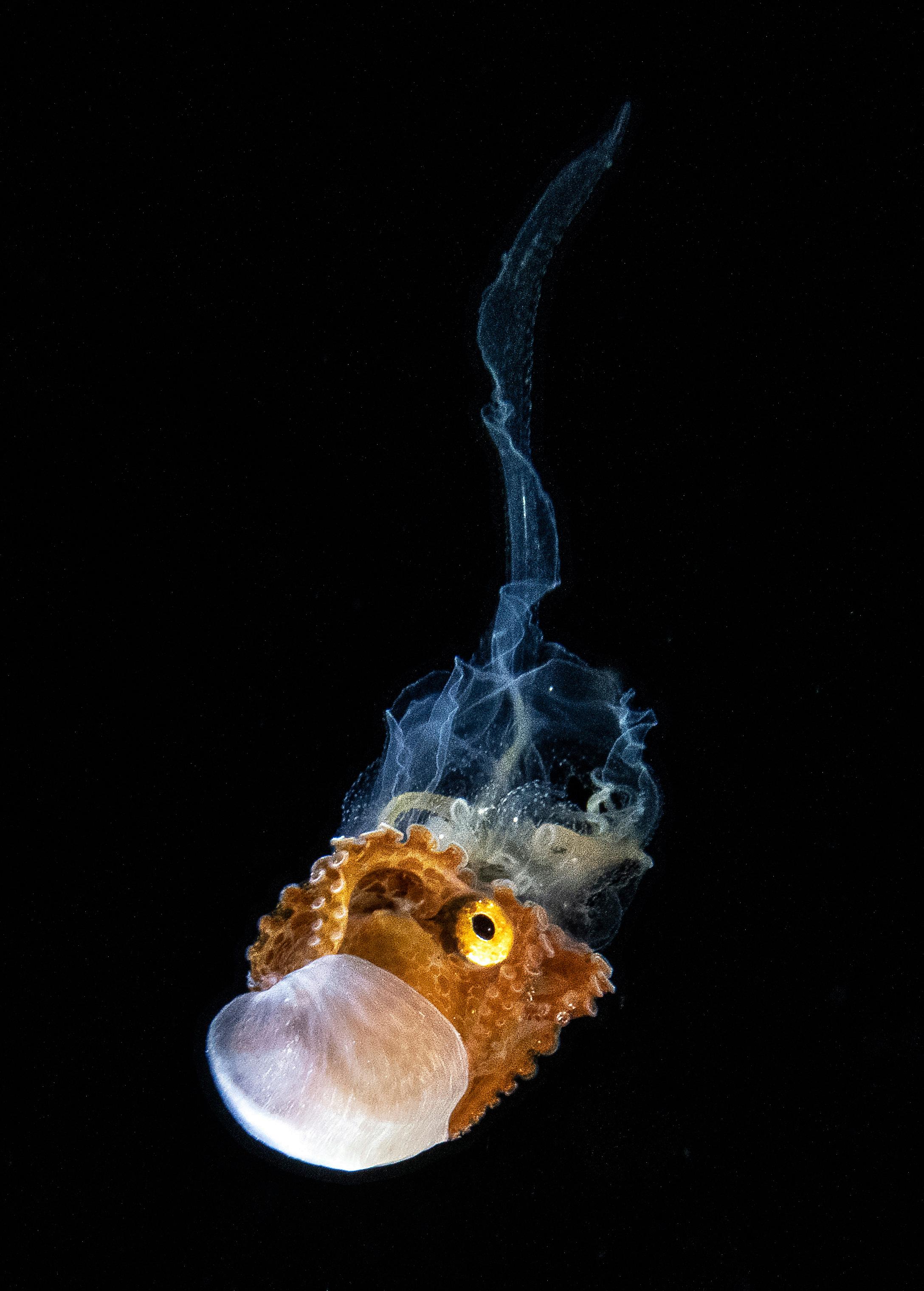
FOCUS
It is all about focus. With exposure and framing, you have a little bit of post-production wiggleroom. But you have to nail the focus in the water. As always, if the subject has eyes, they are the most important focus point. Apertures in the middle of the scope of your lens is always a good compromise. Most lenses are sharpest in this range and it is a good balance between depth-of field-and light sensitivity. I use my Nikon 60 mm on f18 for most shots. The shutter speed is 1/125. My strobes are set on fairly low power to minimize backscatter and lower recycle time. The quick recharge allows me to shoot bursts of images in quick succession to hedge my bet.
If the critter is shiny and reflects the light too much, I compensate with a lower ISO, but otherwise I try to keep the rest of the settings fairly constant.
I have my strobes placed almost perpendicular to the lens to reduce backscatter and strong reflections in the shinier fish scales.
As soon as I have established a focus, I pull the trigger and fire a quick burst ofshots –maybe five orten in quicksuccession. I reframe, adjust focus and fire another round. Most cameras allow you to assign a separate focus button, (look for back-button focus in your camera manual) it is a great advantage not to have focus and shutter assigned to the same button even if this is the default mode most cameras are delivered with.
Most seasoned underwater photographers agree that a full-frame DSLR with a 60 mm lens is the best option for blackwater photos. With a 100 mm or 105 mm lens, it is just too hard to focus. And you can forget about using dioptres or wet-lenses. With a modern fullsensor DSLR camera you can crop the images if necessary to mimic the effect or longer lenses and dioptres, but very often I managed to get very close to enjoy the 60 mm’s very short focus-distance.
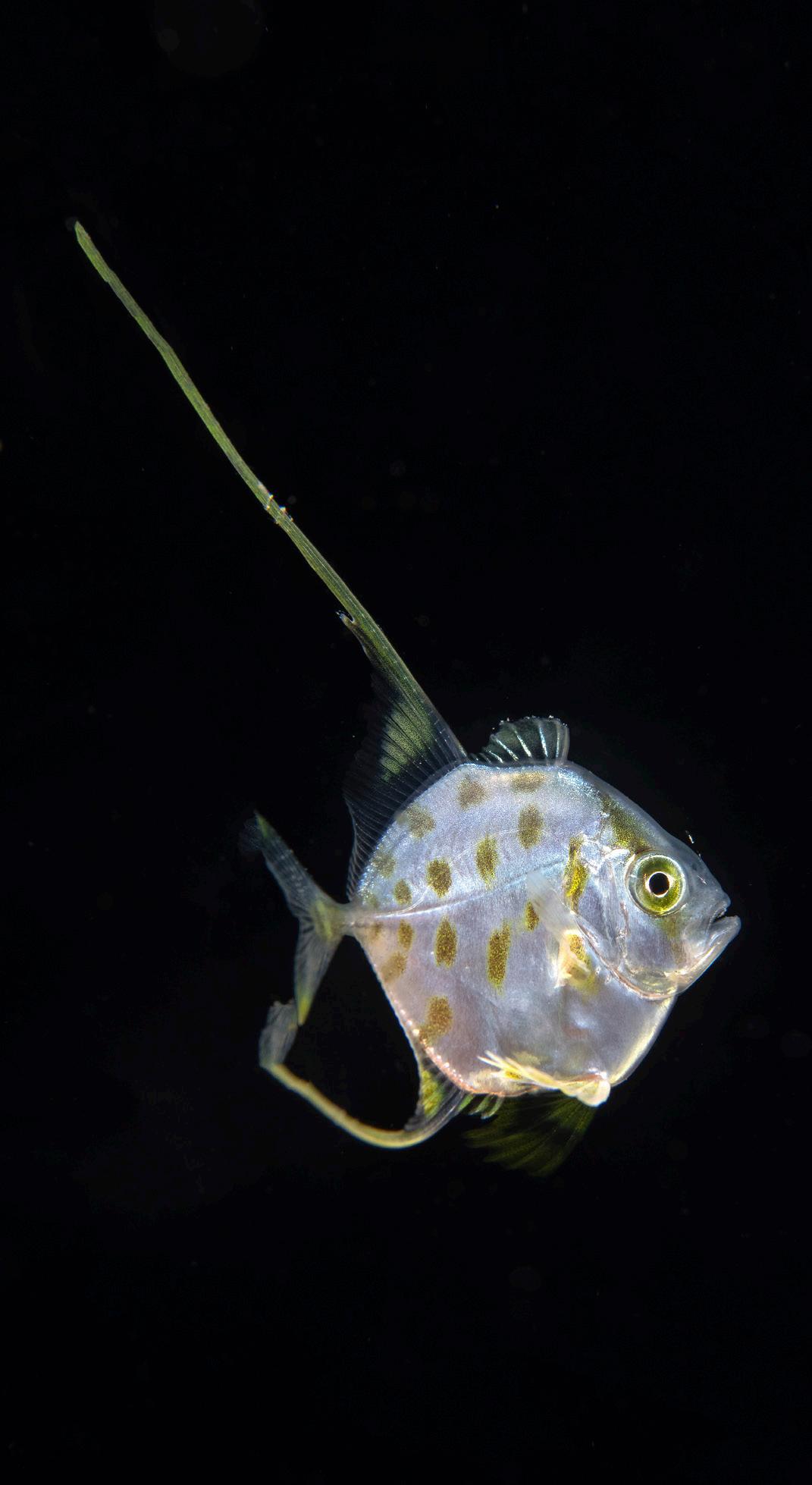
TRANSPARENT CAMOUFLAGE
Some dive operations tether the divers to the line to prevent them from straying too far away. This is a solution looking for a problem and it would certainly limit my freedom of movement and mobility. If you need to be tied to a line not to lose contact or control, you should probably not be diving in the middle of the open ocean at night anyway. If divers have solid buoyancy skills and a good situational awareness, the tether lines are not necessary and will introduce other potential problems. It is better to increase safety with a limited number of divers in the water, and good and alert dive guides too.
Some creatures will seek the lure of the focus light. Almost like a deer in headlights, they freeze not sure what to think about the approaching flashing lights. Others disappear after the first shots, leaving you to hope you got at least a few acceptable exposures before they dashed away. The most difficult subjects are the transparent or translucent organisms. Unfortunately, a big percentage of the nightly creatures are exactly that and that gives them an advantage. Apparently being transparent is the best camouflage when there is no background. For obvious reasons, these creatures are difficult to get in focus and to light. You basically shoot right through them and your lights are eaten up by the infinite darkness in the background.
You have to be very careful when you approach the critters and not create a shockwave when you move forward. Slow deliberate finning and absolutely no swimming movements with your arms is the name of the game. My angled view finder is also a great advantage as it is ergonomically easier to look through the viewfinder and compose the image while staying in flat trim.
The party noise is slowly disappearing in the distance as we head back to the resort jetty after the second dive. I know one thing for cer tain. This first attempt at blackwater photography is not going to be my last.

FACTS – THE VERTICAL MIGRATION
Every night a great vertical migration takes place in all the oceans across the globe. This mass movement rises from the depths to the surface of the sea. Most of the life forms on this journey are so tiny that they are invisible to the naked eye. With the zooplankton comes a variety of both pelagic and larval creatures to feed on the plankton and each other. They swim upward – sometimes more than a kilometre to return the same distance in the morning. These animals are helping to offset carbon dioxide, thus reversing some of the damaging CO 2 emissions caused by us humans. By eating the products of photosynthesis in the surface at night and swimming downward before dawn, the migrating life forms move a huge amount of carbon from the surface to the deep.
Most of these creatures are small planktonic crustaceans called copepods. But trillions of krill, jellyfish, shrimp, squid and other ocean residents join the voyage.
Ichthyoplankton are the eggs and larvae of fish.They are mostly found in the sunlit zone of the water column. The word plankton indicates that they cannot swim effectively under their own powers, but must drift with the ocean currents. Obviously, fish eggs cannot swim at all, and are clearly planktonic. Early stage larvae swim poorly, but later stage larvae swim better and cease to be planktonic as they grow into juveniles. Fish larvae are part of the zooplankton that eat smaller plankton, while fish eggs carry their own food supply. Both eggs and larvae are themselves eaten by larger animals.
Fish can produce high numbers of eggs which are often released into the open water column. The newly hatched young ofoviparous fish are called larvae. They are usually poorly formed, carry a large yolk sac (for nourishment) and are very different in appearance from juvenile and adult specimens. The larval period in oviparous fish is relatively shor t (usually only several weeks), and larvae rapidly grow and change appearance and structure (a process termed metamorphosis) to become juveniles. During this transition, larvae must switch from their yolk sac to feeding on zooplankton prey, a process which depends on typically inadequate zooplankton density, starving many larvae.
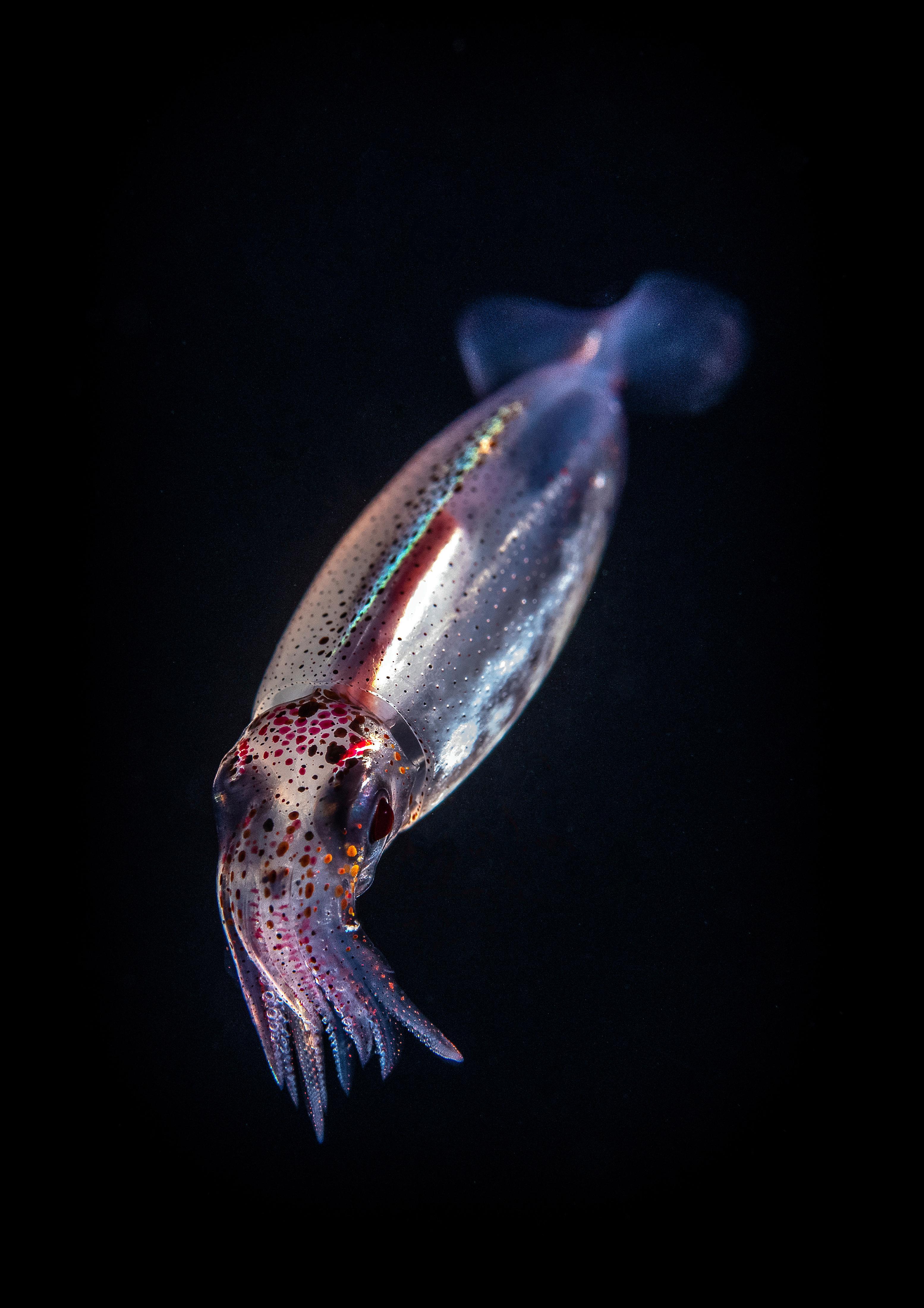
KASAI VILLAGE DIVE RESORT Moalboal on the southwest coast of Cebu is perfectly situated for blackwater dives with easy access to deep nutrient rich waters. Kasai Village Dive Resort is very skilled in organising blackwater dives in a safe and comfortable manner. The knowledgeable and experienced crew makes all the difference. www.kasaivillage.com










